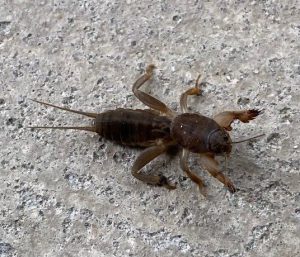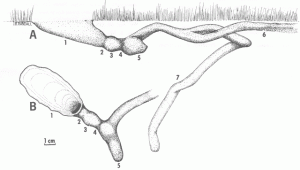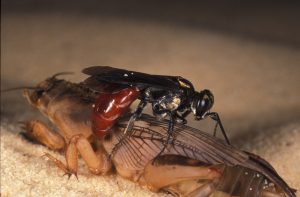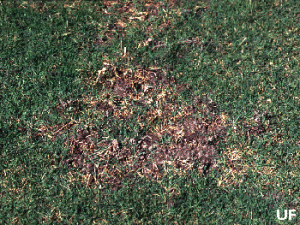
A mole cricket has a face only a mother could love. They are so strange looking, in fact, that in the past week I’ve had two people ask me what they were. They have large, round, helmet-like heads, undersized eyes, and massive front claws used for digging. Unlike your garden-variety crickets, which really don’t cause any major damage to home landscapes, the mole cricket is quite the turfgrass menace. Instead of hopping about aboveground, they tunnel beneath the lawn and feast on the roots and leaves of grass, often destroying entire yards. They are also vegetable pests, going after tomatoes, cabbage, and peppers.

1) horn, 2) 1st constriction, 3) bulb, 4) 2nd constriction, 5) turn-around,
6) surface tunnel, and 7) deep tunnel. Figure 1 from Nickerson et al. 1979. Ann. Entomol. Soc. Am. 72(3):438-440.
Mole crickets spend most of their time below ground and form burrows for hiding, laying eggs, and traversing through their territory. In mating season, males create a monotone song that averages 88 decibels—as loud as a motorcycle! The call comes from their burrows, which have funnel-like openings that expand at the surface, creating amplification comparable to a horn.

The tawny mole cricket (Neoscapteriscus vicinus) is the most common to our area and is an invasive species from South America. UF IFAS has had a specific research program related to mole cricket management since the late 1970’s. One successful outcome of this program has been the introduction of a biological control species, the larra wasp (Larra bicolor). The wasp manages mole cricket populations by stinging and temporarily paralyzing crickets. A female will then deposit an egg into the mole cricket’s body. The cricket recovers and goes about its daily routine until the egg hatches, at which point the larval wasp feeds on and eventually kills the mole cricket. Along with the wasp and release of flies and a nematode that also manage mole crickets, the biocontrol methods introduced between the 1980’s and 2004 have resulted in a 95% reduction in mole cricket populations in north Florida.

If you are seeing mole crickets, you can attract larra wasps to your property by planting shrubby false buttonweed or partridge pea plants, which the wasps feed on. If you have serious damage from mole crickets, check out this thorough Mole Cricket Integrated Pest Management Guide, or contact the horticulture agent at your local county extension office to get a site-specific recommendation for management.
 7
7
